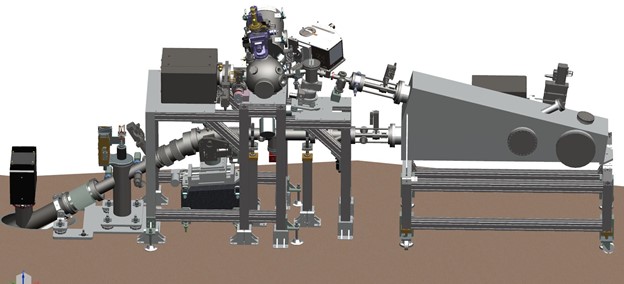P66 serves as a specialized materials science beamline at the PETRA III synchrotron ring. Designed for precision photoluminescence experiments, the beamline offers temporal and spectral resolution, enabling detailed investigations of solids under state-selective excitation through pulsed synchrotron radiation. Central to the beamline's functionality is a double-grating, 2-meter McPherson primary monochromator operating at normal incidence (15⁰) (as depicted in the right portion of Figure 1). This primary monochromator facilitates sample excitation within the 3.7-40 eV energy range.
Samples under investigation are securely mounted on a cryostat double-sided holder (90x30 mm), positioned within a spherical sample chamber shown in the upper section of Figure 1. Throughout the experiments, the samples are maintained in ultrahigh vacuum conditions. Typically, the beamline is employed to analyze various solid-phase materials, including single crystals, glasses, ceramics, films, and powders. The experimental setup allows for the recording of time-resolved emission, excitation, and steady-state reflection and absorption spectra. Emission spectra can be recorded in 110-1200nm range.
The unique pulsed nature of synchrotron radiation enables the accumulation of luminescence decay kinetics spanning from 160 ps to 192 ns. Time-resolved measurements are conducted utilizing the time-correlated photon counting method. The start marker for these measurements is synchronized with the PETRA III bunch clock. Photon registration is performed using a Hamamatsu MCP R3809U-50 detector, and events are recorded by a Cronologic xTDC4 time-to-digital converter card. The full width at half maximum (FWHM) of the system's response function is approximately 160 ps, aligning with the duration of the synchrotron pulse.
@
provided at Large Scale Facilities by:
@
provided at Large Scale Facilities by:
Also consider
Structural & Morphology Characterization
SEM Scanning Electron Microscopy
In SEM a beam is scanned over a sample surface while a signal from secondary or back-scattered electrons is recorded. SEM is used to image an area of the sample with nanometric resolution, and also to measure its composition, crystallographic phase distribution and local texture.
Electronic & Chemical & Magnetic Characterization
XPS X-ray Photoelectron Spectroscopy
XPS is a surface spectroscopic technique for quantitative measurements of the elemental composition or stoichiometry and the chemical state of the present elements, like their oxidation state and chemical bonds. XPS is highly surface sensitive, giving chemical and binding energy information from the a narrow region close to the surface.
Structural & Morphology Characterization
XRD X-Ray Diffraction
XRD provides non-destructive information on the structural order of a material. At large scattering angles XRD permits to identify different crystal phases and to quantify lattice distances and crystalline volume fractions. At low angles of incidence the surface roughness of a single crystal and the thickness of a deposition layer can be obtained.
Electronic & Chemical & Magnetic Characterization
OS Optical spectroscopy
VUV/UV/Vis/NIR spectroscopy is the measurement of the attenuation of a beam of light after it passes through a sample or after reflection from a sample surface. It is useful to characterize absorption, transmission, and reflectivity of a variety of technologically important materials, such as gases, film, pigments, coatings, windows, and filters.
Lithography & Patterning
FIB Focused Ion Beam
By FIB, usually combined with an electron column, it is possible to achieve 2D and 3D nanometric structures, either by ion milling or by ion/electron beam disposition, with a high degree of control and flexibility. Electrical measurements and other characterization are possible. It is a good technique to prepare samples for TEM investigations.








